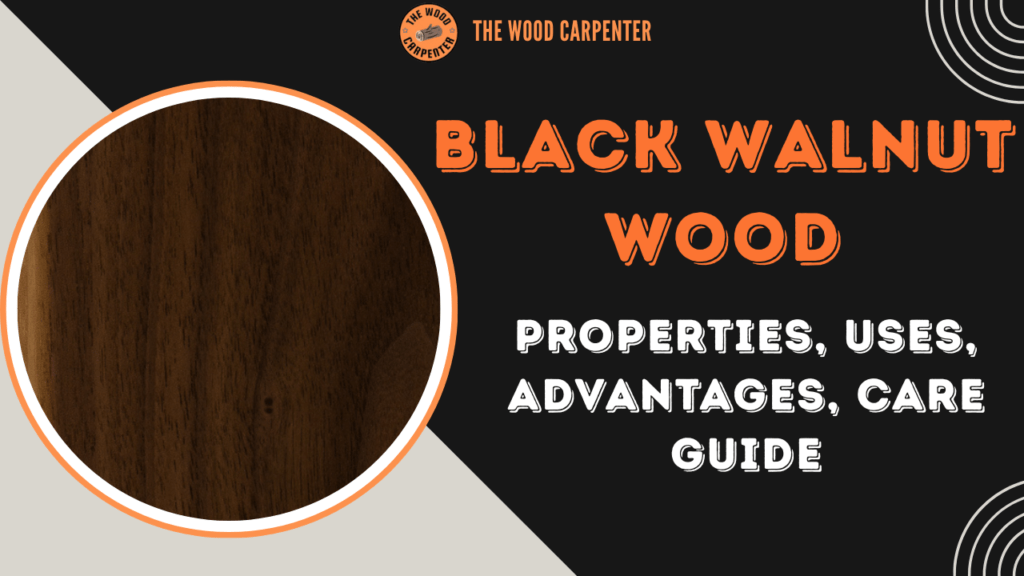
Introduction
Black Walnut wood (Juglans nigra) is among the most highly prized, and sought after hardwood in the world… Favored by fine furniture makers, woodworkers and other craftsmen. Black Walnut may be considered the “king” of North American hardwoods.
If you’re thinking about using Black Walnut in your furniture, flooring, or woodworking project, this all-inclusive guide has got you covered on everything you need to know such as what is Black Walnut, price, pros, cons, and care tips.
What is Black Walnut Wood ?
American Walnut, or Black Walnut, is harvested from the Juglans nigra tree, which mostly grows in the eastern United States. This trees can grow to 100–120 ft (30–37 m) with clear trunks up to 3 ft (1 m) in diameter.
For millennia, this species has been treasured. Its bark, husks and wood were put to use by American Indians for medicine, dyes and tools. Today, Black Walnut is still considered a luxury wood used in the making of higher end furniture, musical instruments and interior finishes.
Appearance of Black Walnut
Colour of the heartwood: It is rich dark chocolate brown with occasional purplish streaks.
Sapwood Description: Yellowish white to creamy white, for a contrasting look.
Grain: Typically straight, but may be curly, wavy or have burly patterns valued for veneers.
Texture: Medium to coarse with an open texture and large pores; finishes well with oil.
This enduring natural beauty, along with the fact it will never go out of style Black Walnut timeless selection for up-scale and contemporary interiors.
Physical & Mechanical Properties
| Property | Value / Range |
| Janka Hardness | ~1,010 lbf (4,490 N) |
| Density (12% MC) | 610 kg/m³ (38 lbs/ft³) |
| Modulus of Rupture | 14,600 lbf/in² (~101 MPa) |
| Elastic Modulus | 1.68 million lbf/in² (~11.6 GPa) |
| Crushing Strength | 7,580 lbf/in² (~52 MPa) |
| Shrinkage (R/T/V) | 5.5% / 7.8% / 12.8% |
Key takeaway: The Black Walnut is moderately hard they are dimensionally stable, and it is resistant to shock, warping, and wear— which makes it ideal for long-lasting projects.
Advantages of Black Walnut Wood
Luxurious Aesthetic: Unique color tones and grain patters you wont find anywhere else.
Durable: Resists warping, cracking and shrinking; can handle aggressive handling.
Workability: Easily workable — cuts, carves and finishes well; can hold fine details.
Stability: Minimal change in shape when dry.
Resistance: Naturally resistant to rot and termites.
Hypoallergenic: Free of sap or resin which minimizes its risk for allergies.
Value Retention: Black Walnut Furniture tends to keep its value year after year.
Disadvantages of Black Walnut Wood
⦁ High Cost: It is one of the expensive types of domestic hardwood.
⦁ Light Sensitivity: It’s dark shade may fade with prolonged exposure to sunlight.
⦁ Scratch Prone: Despite the good hardness, sharp objects can mark the surface.
⦁ Limited Supply: Available of big, clear, wide boards are rare and they are costly.
⦁ Juglone Toxicity: Living trees release juglone, which is toxic to certain plants, pets (like horses and dogs), but finished wood products are safe.
Common Uses of Black Walnut
Thanks to its beauty and resilience, Black Walnut is used in:
⦁ Furniture: Tables, chairs, desks, cabinets
⦁ Flooring: High quality solid wood or engineered floor.
⦁ Musical Instruments: Guitars, violins, flutes
⦁ Kitchenware: Food-safe kitchenware (when finished) such as cutting boards, bowls, utensils
⦁ Decor & Art: Veneers, carvings, turned objects
⦁ Gunstocks: Popular for its resilience and shock resistance
Black Walnut vs. Other Hardwoods
| Feature | Black Walnut | Teak | Mahogany |
| Janka Hardness | 1,010 lbf | 1,000–1,155 lbf | 800 lbf |
| Durability | Very durable | Extremely durable | Durable |
| Rot Resistance | Strong | Excellent (natural oils) | Moderate |
| Color | Dark brown | Golden brown | Reddish-brown |
| Cost | High | Very high | Moderate |
Black Walnut competes with teak and mahogany in durability and aesthetics but remains more affordable than exotic teak.
Pricing & Availability
⦁ Average Price: It’s around $6–$13 per board foot (varies by region, thickness, and grade).
⦁ Premium Slabs: Wide, figured boards (or live-edge slabs) are capable for bringing significantly higher prices.
⦁ Availability: It is Common in North America; and sold worldwide.
Care & Maintenance Tips
To ensure Black Walnut furniture and flooring lasts for generations:
⦁ Avoid Sunlight: Try to use UV-protective finishes or oils to prevent the fading.
⦁ Regular Dusting: Use a soft, clean cloth to dust often.
⦁ Oiling/Waxing: Apply linseed oil, beeswax, or coconut oil every 6–12 months.
⦁ Polishing: Use the silicone-based polish for indoor furniture.
⦁ Scratch Prevention: Use coasters, mats, and felt pads under the heavy objects.
FAQs About Black Walnut
1. Is Black Walnut wood good quality ?
Yes, it is a fine hardwood worth saving for it’s strength, durability and beauty throughout time.
2. How long does Black Walnut wood last ?
Indoors, it can endure for centuries. Outside (if properly treated), it can survive about 20 years.
3. Is Black Walnut better than oak ?
Walnut has a richer visual and tactile quality but oak is harder and more economical.
4. Is Black Walnut food-safe ?
Yes. Finished Black Walnut is safe for cutting boards, bowls, and utensils.
5. Why is Black Walnut so expensive ?
Its slow growth, lack of readily available wide boards and high demand make it a desirably priced hardwood.
6. Is black walnut a good wood ?
Yes, Black Walnut is tough, strong, and gorgeous, which is why it’s one of the top hardwoods for furniture and woodworking.
7. Why is black walnut wood so valuable ?
Its value comes from its rich, dark color, unique swirls and streaks of grain, resistance to rot, and relative scarcity.
8. How rare is black walnut wood ?
Black Walnut isn’t extremely rare but wide, high-quality boards are limited, which increases its price and demand.
Conclusion
Black Walnut is a high-end wood that makes beautiful, long lasting wood working projects and accents. Practically the only complaint is that it’s very expensive – but, given this timeless looks and durability due to its high-end construction & materials, it really pays dividends on that initial outlay.
When you’re looking for a wood that boasts beauty and durability, one that’s guaranteed to add value to your home while only getting better with age, you can do no better than Black Walnut – it truly is one of the very best options available.

